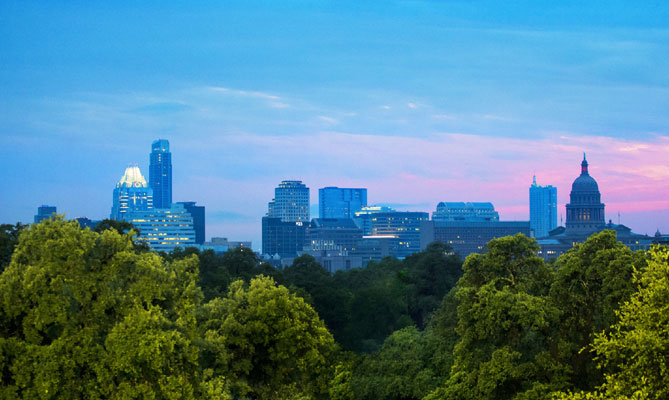Austin, Texas is a great place to live. The warm, friendly people, the vibrant culture, and the promising job market is just something to die for.
But there is even more reason for moving and settling in Austin – the glorious weather. The atmospheric conditions of this wonderful city are well-balanced to let you delight in every moment of every season.
And if you are blessed with a big yard, you can very well spruce up your home by introducing some greenery. And guess what? We have a list of the best trees to plant in Austin to get you started!
5 Best Trees To Plant In Austin
There are many different types of trees in Austin, all with different characteristics and attractiveness. In this list, we have some that are shade trees and others that are just ornamental species. Read on to see which ones meet your personal preferences.
-
Magnolia
Also known as the southern trees, magnolias are drought resistant, which makes them the perfect choice for people living in Austin. They have enormous glossy, dark green leaves and large, waxy, brilliant white flowers that leave your eyes wanting for more.
This tree species thrives well in full sun and deep well-drained soils, which Austin has no problem providing. When conditions are right, magnolias can grow up to 70 feet tall, but they can be trimmed and pruned for small patio spaces.
-
American Holly
The American holly is yet another excellent choice for people looking for the best types of trees in Austin. Its glossy evergreen foliage coupled with the beautiful red berries that sprout in spring are one of the reasons the tree is a favorite of many. Some species produce orange berries that homeowners love too.
Taken good care of, the American holly can grow up to 30 feet tall. It is resistant to heat and drought and does great even in poorly drained soils.
-
Southern Red Oak
If you have deeper soil, the southern red oak will be a great option. Also sometimes referred to as Spanish oak, the southern red oak is a fairly large tree and can grow up to 80 feet tall, and up to 3 feet in diameter.
It has adapted to thrive on the limestone slopes in Austin, obtaining nutrition and nourishment from the iron deposits. Planted in deep, fertile soil, the tree will grow magnificently and can live for over 100 years. Arborists will typically recommend southern red oaks in places with shaded root zones to prevent bacterial leaf scorch.
-
Texas Ash
The beloved Texas ash is native to Austin and creates a beautiful shade area for homeowners. It is thinner than most types of trees in Austin and grows to about 30 feet tall. The tree has rich dark green leaves, and requires very little maintenance.
It can thrive in extreme weather conditions and poorly drained soils. The only downside is that this tree usually has a lifespan of about 15 years, and so it may not be such a great investment for people looking to live in one place for some time.
-
Bur Oak
Like the southern red oaks, bur oaks require deep, fertile soil and plenty of space to grow. When conditions are favorable, they can grow up to a height of 100 feet, producing large leaves and acorns.
If your space is large enough, a couple bur oaks would be the perfect way to add some shade to your yard. They are some of the best trees to plant in Austin because not only are they tolerant to drought and resistant to heat but also attract wildlife to beautify your yard.
FAQs

Q: What Kind Of Trees Grow In Austin TX?
A: The kind of trees that grow in Texas are those that are drought tolerant and heat resistant. They include the magnolia, American holly, southern red oak, Texas ash, and bur oak. Some can be used as shade trees while others can be pruned for constricted patio spaces.
Q: What Is The Best Tree To Plant In Texas?
A: The best tree to plant in Texas is the magnolia because not only is it resistant to heat but also to diseases, which makes it easier to care for and maintain. If you live in a place with a warm or dry climate like Austin, your magnolia species may benefit from the hot afternoon sun.
Q: What Trees Grow The Fastest In Texas?
A: The Drummond red maple, desert willow, green ash, Chinese parasol tree, dawn redwood, Mexican sycamore, Montezuma cypress, Monterrey oak, Chinese empress tree, and cherry laurel are trees that grow the fastest in Austin.
However, when choosing a tree for your property, it is best to get one with a slow growth rate. Fast growing trees usually produce weak wood, which can make the trees more unsafe than the slower growing ones. They also have a shorter lifespan.
Q: What Grows Best In Austin Texas?
A: The list of things that grow best in Texas is endless. In January, February, and March, the local gardens will be thriving with asparagus, carrots, lettuces, and radishes. April, May, and June will favor black eye peas, broccoli, eggplant, peppers, pumpkin, snap beans, sweet corn, and tomatoes.
In July, August, and September, farmers can have beets, cauliflower, chard, cucumbers, potatoes, and mustard. In October, November, and December, they can plant beets, lettuces, radishes, spinach, and turnips.
Q: What Is The Fastest Growing Shade Tree In Texas?
A: Bur Oak is the fastest growing shade tree in Texas, taking only 35 years to reach its maturity. This is quite a short duration compared to other oak varieties like the Live oak that takes over 75 years to mature. Bur oak grows tall and wide and can exceed 100 feet both in height and in width, which is why it is one of the best trees to shade your Austin property.
Tree Service Removal Overview
When it comes to choosing the best trees to plant in Austin, it is always important to think about what you hope to achieve. Are you looking for shade? Decoration? Or both? Different tree species can be used to serve different purposes in regard to giving a property a face lift. Taller trees like oaks will be perfect for shade while the shorter ones like Texas ash and American molly will be perfect for decoration.



